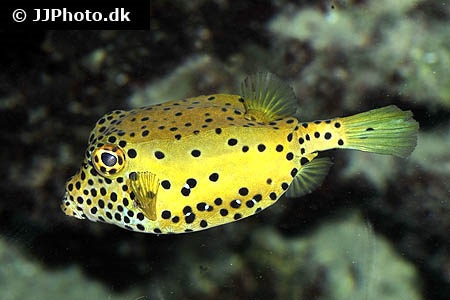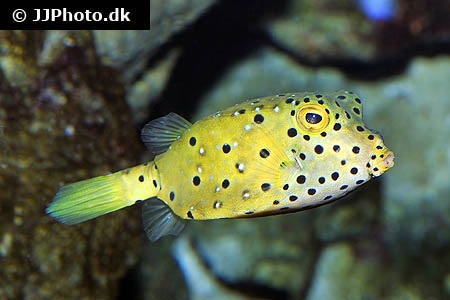Ostracion cubicus
| Latin name | Ostracion cubicus - Linnaeus, 1758 |
|---|---|
| Local name | Yellow boxfish |
| Family | Ostraciidae - Ostracion |
| Origin | East Indian Ocean, West Indian Ocean, Australia, The Red Sea, Indonesia, East Pacific, Central/West Pacific |
| Max length | 45 cm (17.7") |
| Minimum volume |
800 l (211 gal) |
|---|---|
| Hardiness |
Delicate |
| Suitable for aquarium |
Experience, preparation and extra care required |
| Reef safe |
Not reef safe |
| Aggressiveness | Unknown |
| Recommended |
Macroalgea (Eg. seaweed / nori) Small crustaceans (Krill, mysis, artemia...) |
|---|---|
| Mostly |
Large polyp stone coral (LPS) Other invertebrates Soft coral |
| Maybee |
Larger crustaceans (Shrimp, crabs...) |
This species likes to eat tubeworms.
This species will eat shrimps, crabs, small bivalves, snails and the like.
This species has a toxin in its skin, which it releases when highly stressed or dying.
This poison can kill all the aquatic life in the aquarium, if unlucky.
This species needs a very large aquarium when fully grown.
Exactly how big the aquarium should be is hard to say, but the size of this species is such, that it cannot normally be kept in a home aquarium.
There is a greater chance of success with this species if one can supply a living feed to allow it to adapt to the tank.
This species cannot maneuver in strong currents, especially so when small.
Pay particular attention to the pump’s water inlet as these fish in certain circumstances, can get stuck.
This species often has a fun and interesting personality.
Boxfish(Ostraciidae) have a unique square shape and a particular way of swimming.
They have a rather special personality, which one quickly comes to love.
Boxfish live typically off a mixture of algae, coral polyps, zooplankton, and in some cases crustaceans.
They are not normally reef safe and when small will require gentle water circulation.
Boxfish can secrete a poison when stressed or if they die, which can in the worst case, kill the contents of a whole aquarium.
Never use the water the fish was transported in.
| Aquarium trade | Yes |
|---|---|
| Distribution | Indo-Pacific: Red Sea and East Africa (Ref. 3141) to the Hawaiian and Tuamoto islands, north to Ryukyu Islands, south to Lord Howe Island. The Red Sea population differs slightly in coloration and has been known as Ostracion argus; closely relate |
| English common names |
Spotted box fish Yellow boxfish Cube trunkfish Black-spotted boxfish Boxfish |
| French common names |
Bourse coffre Poisson coffre jaune Poulet de la mer |
| Danish common names |
Plettet kuffertfisk |
Bob Fenner. The Puffers Called Box-, Cowfishes, family Ostraciidae - Wet Web Media - (English)
Richard Aspinall. 2012. Oddballs for the Marine Aquarium - Tropical Fish Hobbyist - (English)




